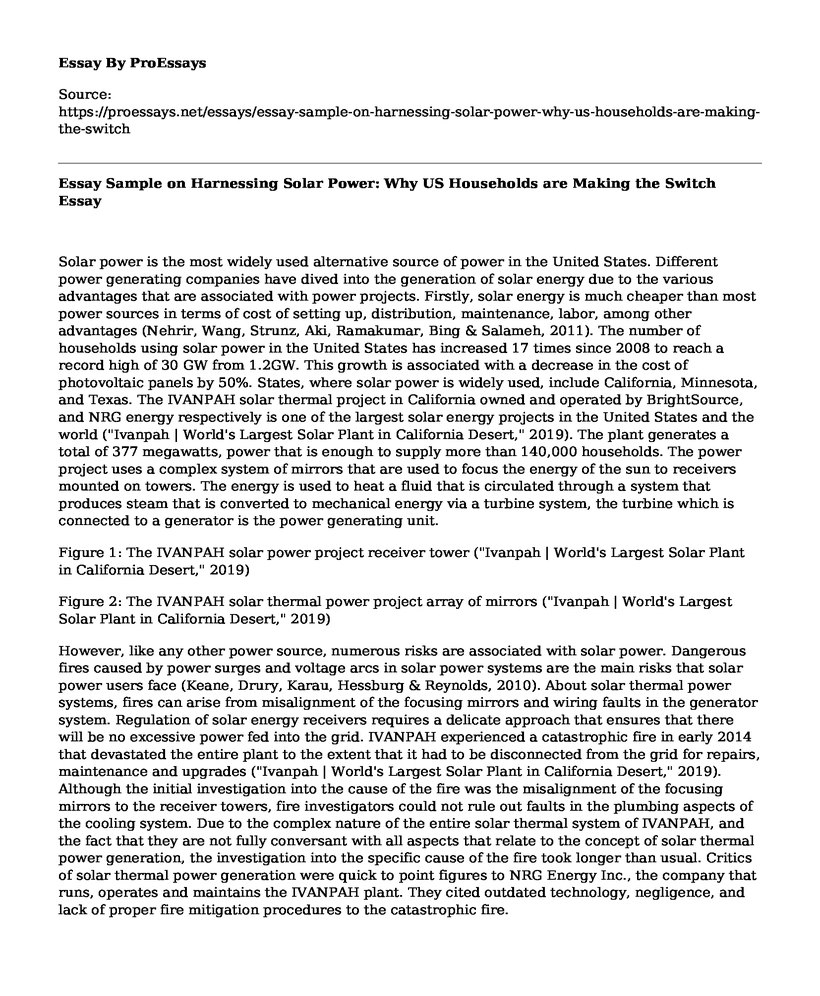Solar power is the most widely used alternative source of power in the United States. Different power generating companies have dived into the generation of solar energy due to the various advantages that are associated with power projects. Firstly, solar energy is much cheaper than most power sources in terms of cost of setting up, distribution, maintenance, labor, among other advantages (Nehrir, Wang, Strunz, Aki, Ramakumar, Bing & Salameh, 2011). The number of households using solar power in the United States has increased 17 times since 2008 to reach a record high of 30 GW from 1.2GW. This growth is associated with a decrease in the cost of photovoltaic panels by 50%. States, where solar power is widely used, include California, Minnesota, and Texas. The IVANPAH solar thermal project in California owned and operated by BrightSource, and NRG energy respectively is one of the largest solar energy projects in the United States and the world ("Ivanpah | World's Largest Solar Plant in California Desert," 2019). The plant generates a total of 377 megawatts, power that is enough to supply more than 140,000 households. The power project uses a complex system of mirrors that are used to focus the energy of the sun to receivers mounted on towers. The energy is used to heat a fluid that is circulated through a system that produces steam that is converted to mechanical energy via a turbine system, the turbine which is connected to a generator is the power generating unit.
Figure 1: The IVANPAH solar power project receiver tower ("Ivanpah | World's Largest Solar Plant in California Desert," 2019)
Figure 2: The IVANPAH solar thermal power project array of mirrors ("Ivanpah | World's Largest Solar Plant in California Desert," 2019)
However, like any other power source, numerous risks are associated with solar power. Dangerous fires caused by power surges and voltage arcs in solar power systems are the main risks that solar power users face (Keane, Drury, Karau, Hessburg & Reynolds, 2010). About solar thermal power systems, fires can arise from misalignment of the focusing mirrors and wiring faults in the generator system. Regulation of solar energy receivers requires a delicate approach that ensures that there will be no excessive power fed into the grid. IVANPAH experienced a catastrophic fire in early 2014 that devastated the entire plant to the extent that it had to be disconnected from the grid for repairs, maintenance and upgrades ("Ivanpah | World's Largest Solar Plant in California Desert," 2019). Although the initial investigation into the cause of the fire was the misalignment of the focusing mirrors to the receiver towers, fire investigators could not rule out faults in the plumbing aspects of the cooling system. Due to the complex nature of the entire solar thermal system of IVANPAH, and the fact that they are not fully conversant with all aspects that relate to the concept of solar thermal power generation, the investigation into the specific cause of the fire took longer than usual. Critics of solar thermal power generation were quick to point figures to NRG Energy Inc., the company that runs, operates and maintains the IVANPAH plant. They cited outdated technology, negligence, and lack of proper fire mitigation procedures to the catastrophic fire.
Figure 3: The generator room after a fire incident ("Ivanpah | World's Largest Solar Plant in California Desert," 2019)
Additionally, the PV solar segment of the IVANPAH project also relates to solar investigations in several ways. Investigators have a hard time establishing whether the fires that happen often are caused by the excessive voltage generated by the mega solar panels at the plant to create voltage arcs or due to internal manufacturing faults of the individual photovoltaic cells that are interlinked to make the solar panels (Nehrir et al., 2011). Fire investigators also have a hard time making recommendations as to how fires can be prevented in future NRG energy Inc.
References
Ivanpah | World's Largest Solar Plant in California Desert. (2019). Retrieved 25 July 2019, from http://www.brightsourceenergy.com/ivanpah-solar-project#.XTn0244zZxA
Keane, R. E., Drury, S. A., Karau, E. C., Hessburg, P. F., & Reynolds, K. M. (2010). A method for mapping fire hazard and risk across multiple scales and its application in fire management. Ecological Modelling, 221(1), 2-18.
Nehrir, M. H., Wang, C., Strunz, K., Aki, H., Ramakumar, R., Bing, J., ... & Salameh, Z. (2011). A review of hybrid renewable/alternative energy systems for electric power generation: Configurations, control, and applications. IEEE Transactions on Sustainable Energy, 2(4), 392-403.
Cite this page
Essay Sample on Harnessing Solar Power: Why US Households are Making the Switch. (2023, Jan 30). Retrieved from https://proessays.net/essays/essay-sample-on-harnessing-solar-power-why-us-households-are-making-the-switch
If you are the original author of this essay and no longer wish to have it published on the ProEssays website, please click below to request its removal:
- Urban Heat Islands
- Course Work: Effects of Groundwater Contamination. Water Treatment. Drinking Water Quality.
- Essay on U.S. CAFE Standards: Reducing Pollution & Increasing Fuel Economy
- Essay Example on Wind Turbines: Safe Renewable Energy for Climate and Human Health
- Essay Sample on Monopoly: Market Structure & Natural Resource Control
- Essay Example on Apple Inc: Value Chain & Value-Creating Events
- Essay Sample on Michigan State: A Region of Achievements, Failure, and Calamity







